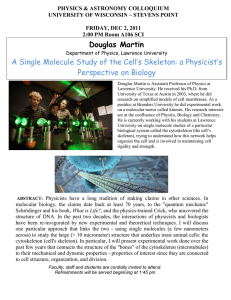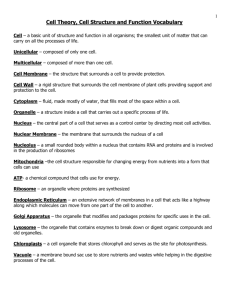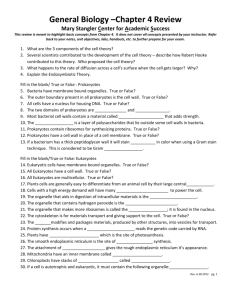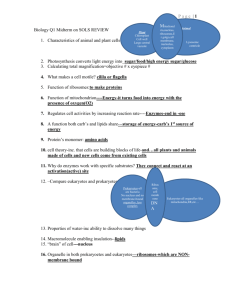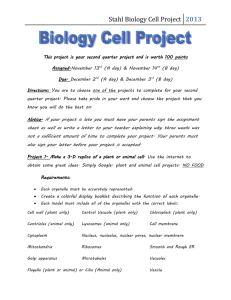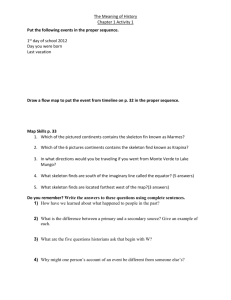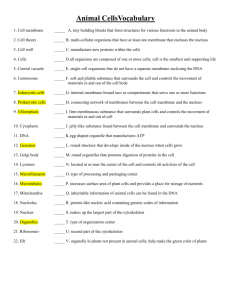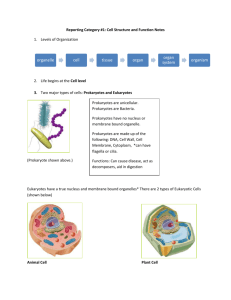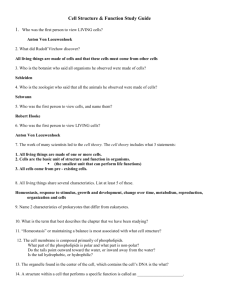PGS
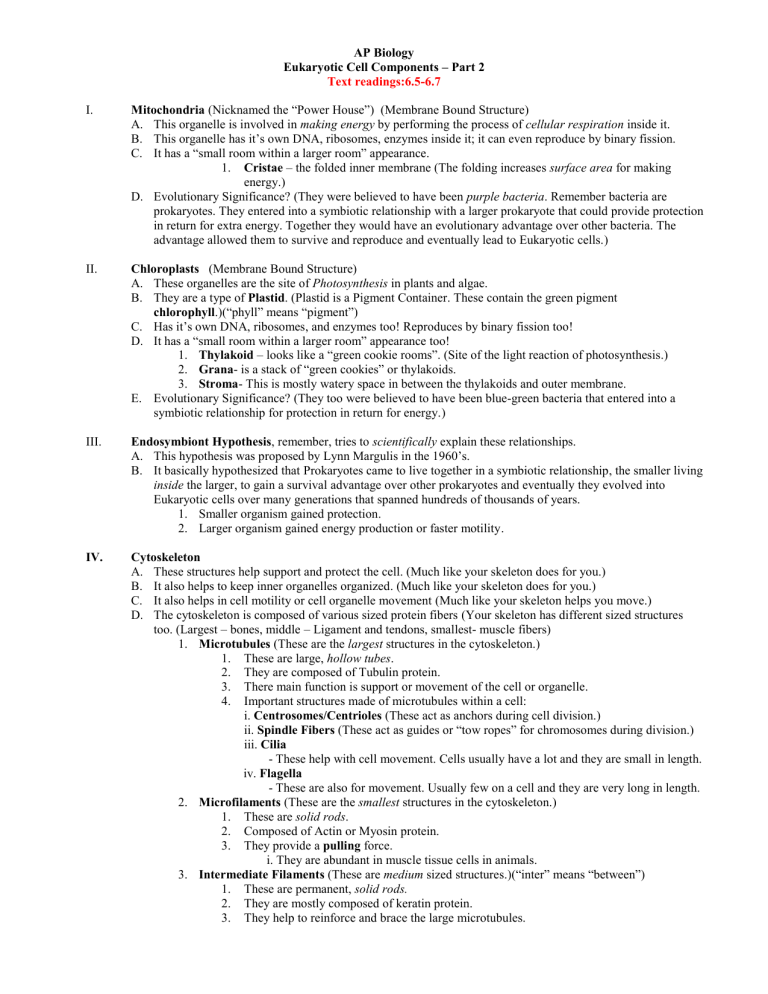
I.
AP Biology
Eukaryotic Cell Components – Part 2
Text readings:6.5-6.7
Mitochondria (Nicknamed the “Power House”) (Membrane Bound Structure)
A.
This organelle is involved in making energy by performing the process of cellular respiration inside it.
B.
This organelle has it’s own DNA, ribosomes, enzymes inside it; it can even reproduce by binary fission.
C.
It has a “small room within a larger room” appearance.
1.
Cristae – the folded inner membrane (The folding increases surface area for making energy.)
D.
Evolutionary Significance? (They were believed to have been purple bacteria . Remember bacteria are prokaryotes. They entered into a symbiotic relationship with a larger prokaryote that could provide protection in return for extra energy. Together they would have an evolutionary advantage over other bacteria. The advantage allowed them to survive and reproduce and eventually lead to Eukaryotic cells.)
II.
Chloroplasts (Membrane Bound Structure)
A.
These organelles are the site of Photosynthesis in plants and algae.
B.
They are a type of Plastid . (Plastid is a Pigment Container. These contain the green pigment chlorophyll .)(“phyll” means “pigment”)
C.
Has it’s own DNA, ribosomes, and enzymes too! Reproduces by binary fission too!
D.
It has a “small room within a larger room” appearance too!
1.
Thylakoid – looks like a “green cookie rooms”. (Site of the light reaction of photosynthesis.)
2.
Grana - is a stack of “green cookies” or thylakoids.
3.
Stroma - This is mostly watery space in between the thylakoids and outer membrane.
E.
Evolutionary Significance? (They too were believed to have been blue-green bacteria that entered into a symbiotic relationship for protection in return for energy.)
III.
Endosymbiont Hypothesis , remember, tries to scientifically explain these relationships.
A.
This hypothesis was proposed by Lynn Margulis in the 1960’s.
B.
It basically hypothesized that Prokaryotes came to live together in a symbiotic relationship, the smaller living inside the larger, to gain a survival advantage over other prokaryotes and eventually they evolved into
Eukaryotic cells over many generations that spanned hundreds of thousands of years.
1.
Smaller organism gained protection.
2.
Larger organism gained energy production or faster motility.
IV.
Cytoskeleton
A.
These structures help support and protect the cell. (Much like your skeleton does for you.)
B.
It also helps to keep inner organelles organized. (Much like your skeleton does for you.)
C.
It also helps in cell motility or cell organelle movement (Much like your skeleton helps you move.)
D.
The cytoskeleton is composed of various sized protein fibers (Your skeleton has different sized structures too. (Largest – bones, middle – Ligament and tendons, smallest- muscle fibers)
1.
Microtubules (These are the largest structures in the cytoskeleton.)
1.
These are large, hollow tubes .
2.
They are composed of Tubulin protein.
3.
There main function is support or movement of the cell or organelle.
4.
Important structures made of microtubules within a cell: i. Centrosomes/Centrioles (These act as anchors during cell division.) ii. Spindle Fibers iii. Cilia
(These act as guides or “tow ropes” for chromosomes during division.)
- These help with cell movement. Cells usually have a lot and they are small in length.
iv. Flagella
- These are also for movement. Usually few on a cell and they are very long in length.
2.
Microfilaments (These are the smallest structures in the cytoskeleton.)
1.
These are solid rods .
2.
Composed of Actin or Myosin protein.
3.
They provide a pulling force. i. They are abundant in muscle tissue cells in animals.
3.
Intermediate Filaments (These are medium sized structures.)(“inter” means “between”)
1.
These are permanent, solid rods.
2.
They are mostly composed of keratin protein.
3.
They help to reinforce and brace the large microtubules.
V.
VI.
Protective or weight bearing structures for cells
A.
Cell Wall of Plant Cells (composed of cellulose primarily)
B.
Cell Walls of Fungus (Composed of the carbohydrate called Chitin . )
C.
Extra Cellular Matrix (ECM)
1.
This is the outer protective “skeleton” of the cell plasma membrane in animal cells. (“extra” means
“outside of”; “matrix” means “skeleton”)
2.
It also functions in communication with other cells.
A CELL IS THE SUM OF IT”S PARTS!
It is the basic unit of life only when all the parts work together to make “LIFE” possible.
